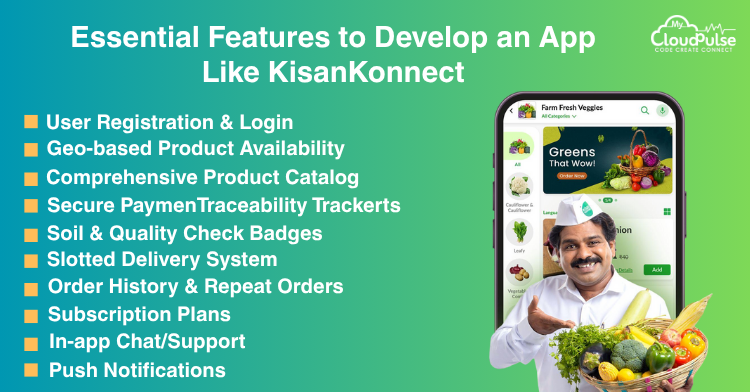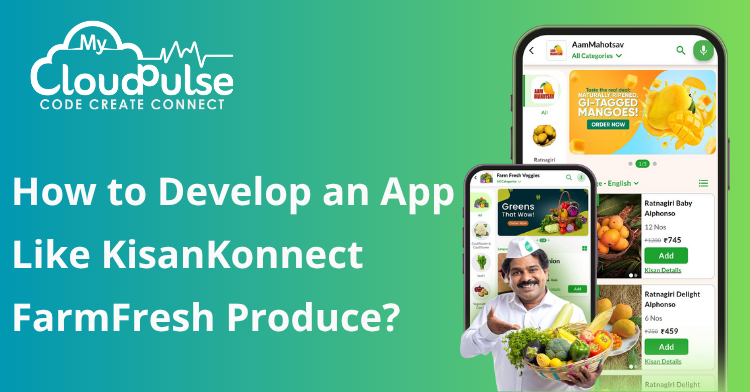In recent years, the demand for farm-fresh, traceable, and sustainably sourced food has seen a significant surge. Consumers are increasingly becoming conscious of what they eat, where it comes from, and how it’s grown. Amidst this growing shift towards healthy and ethical consumption, apps like KisanKonnect FarmFresh Produce have emerged as frontrunners in revolutionizing the farm-to-fork experience. If you’re looking to enter the agri-tech space, now is the perfect time to develop an app like KisanKonnect and empower both farmers and health-conscious consumers through technology.
KisanKonnect has successfully bridged the gap between responsible farmers and conscious consumers by providing a platform that offers fresh, hygienic, and traceable farm produce directly to the doorstep. If you’re inspired by this model and are looking to develop a similar app, this comprehensive guide will walk you through the essential steps, features, technology, and team structure required to build an app like KisanKonnect.
App Stats
Before diving into the development process, it helps to look at some key stats that define the success of KisanKonnect:
- App Name: KisanKonnect – FarmFresh Produce
- Platform: Android (available on Google Play Store)
- Category: Shopping / Farm Produce
- User Base: 2.5 lakh+ happy customers
- Farmer Network: 5,000+ farmer families
- Operational Regions: Mumbai and Pune
- Offline Stores: Navi Mumbai and Thane
- Downloads: 100K+ (Play Store)
- Average Rating: 4.5+ (as of mid-2025)
These stats show not just market viability but also a clear demand for a sustainable, quality-first, and farm-centric grocery delivery model.
Key Highlights
KisanKonnect has become a trusted name in farm-fresh delivery by combining innovation with ethical practices. Below are the expanded highlights that form the foundation of its unique offering:
Direct Farm-to-Home Model:
KisanKonnect eliminates the traditional middlemen, enabling direct transactions between farmers and consumers. This ensures fair prices for growers and unadulterated freshness for end users.
Traceability:
Users can trace their order back to the exact farm and even learn about the farmer who cultivated it. This transparency builds trust and strengthens the bond between buyer and grower.
Sustainability-Focused:
With an emphasis on regenerative agriculture, KisanKonnect supports soil testing and environment-friendly practices that ensure long-term soil health and biodiversity.
Diverse Product Range:
Beyond fruits and vegetables, the app offers cold-pressed oils, atta, flowers, Mom’s kitchen snacks, pan-mixes, and ready-to-eat salads, all sourced from villages and small producers.
Offline Expansion:
KisanKonnect smartly combines online presence with physical stores in Navi Mumbai and Thane, giving consumers a touch-and-feel experience while strengthening local distribution.
Community Impact:
The platform connects over 5,000 farmer families with 250,000+ urban households, truly embodying the spirit of community-supported agriculture.
Essential Features to Develop an App Like KisanKonnect
Creating an effective farm-to-fork delivery app means addressing customer pain points, building farmer engagement, and ensuring seamless logistics. Here are the essential features:

1. User Registration & Login
Secure and user-friendly login options via phone number OTP, Google, or social platforms, ensuring fast access and personalization from the first step.
2. Geo-based Product Availability
By detecting the user’s location, the app ensures that only regionally available products are shown, helping with inventory and reducing delivery time.
3. Comprehensive Product Catalog
Well-organized categories for fruits, vegetables, grains, oils, snacks, and more, each with detailed descriptions, images, pricing, weight options, and nutritional info.
4. Traceability Tracker
A powerful feature that displays the name of the farm, farmer, location, harvest date, and farming method for each item. Builds transparency and educates the buyer.
5. Soil & Quality Check Badges
Visual indicators confirming that produce has passed hygiene, pesticide-free, and soil quality checks, reinforcing safety and quality commitment.
6. Slotted Delivery System
Customizable time slot selection improves delivery predictability and user convenience while optimizing logistics at the backend.
7. Order History & Repeat Orders
Let users easily view past purchases and reorder frequent items with a single click. Saves time and boosts repeat sales.
8. Subscription Plans
Offer weekly or monthly subscription models for essentials, with the flexibility to skip or modify deliveries based on user availability.
9. In-app Chat/Support
Provide instant support through chatbots or human agents for order inquiries, product information, and issue resolution.
10. Push Notifications
Inform users about new arrivals, offers, delivery updates, and app promotions in real-time, helping increase user engagement.
Advanced Features
To build a next-gen app that stands out in the competitive market, consider integrating the following advanced capabilities:
1. AI-Powered Recommendations
Use AI to analyze past behavior and offer personalized product suggestions, helping users discover items they are likely to buy.
2. Blockchain for Supply Chain Transparency
Employ blockchain to verify every step of the supply chain—from farm input to final delivery. Users can trust the accuracy of farming practices, dates, and locations.
3. Farmer Profiles and Stories
Include detailed pages for each farmer, featuring bios, farm photos, interviews, and farming techniques. Adds emotional value and builds brand loyalty.
4. Dynamic Pricing Engine
Adjust prices automatically based on factors like supply-demand ratios, weather patterns, and harvest yields. Helps both consumers and farmers manage expectations.
5. Voice Search Integration
Let users search for items using voice commands for quicker navigation, particularly beneficial for older users or those less tech-savvy.
6. Eco Score Display
Display a sustainability score for each product based on packaging, transportation impact, and farming practices. Educates customers and promotes conscious choices.
7. Offline Store Sync
Connect your digital and physical stores through a unified inventory system. Enables users to shop online and pick up from nearby farm stores.
Monetization Models
An app like KisanKonnect can generate revenue through multiple channels. Here’s a deeper dive:
1. Product Margin
Earn commissions or add fixed profit margins on all items sold. Transparent pricing models benefit both farmers and platform owners.
2. Subscription Plans
Offer paid subscription boxes with added benefits like free delivery, exclusive produce, early access to new items, and seasonal boxes.
3. In-app Advertising
Allow farmer brands, organic suppliers, or allied eco-friendly companies to promote their offerings inside the app through banners or featured listings.
4. Delivery Charges
Implement delivery charges for small orders or offer tiered pricing based on speed or delivery zones.
5. Affiliate Sales
Promote relevant third-party products like kitchenware, compost kits, or eco-living goods and earn through affiliate commissions.
6. B2B and Wholesale Sales
Partner with hotels, restaurants, cafes, and housing societies by offering bulk order capabilities and loyalty programs for businesses.
Process to Develop an App Like KisanKonnect
Building a robust and scalable app like KisanKonnect involves multiple phases, each requiring attention to detail and strategic planning:
1. Market Research & Competitor Analysis
Identify existing competitors, understand customer expectations, and validate your app concept. Use surveys and analytics tools to gather real-world insights.
2. Requirement Gathering
Define your app’s goals, features, user roles (consumer, farmer, admin), target locations, delivery methods, and monetization strategy. Create a Product Requirements Document (PRD).
3. UI/UX Design
Sketch wireframes and create interactive prototypes. Focus on simplicity, speed, and accessibility, especially for non-tech-savvy rural and urban users.
4. Front-end & Back-end Development
Choose modern frameworks like React Native or Flutter for the mobile app. Use Node.js or Django for the backend. Ensure the architecture is scalable and API-driven.
5. Integrations
Incorporate third-party APIs for payments (Razorpay, Stripe), maps (Google Maps), push notifications (Firebase), SMS gateways, analytics (Mixpanel), and CRM tools.
6. Testing
Conduct functional, usability, performance, and security testing. Include real users in beta testing to identify and fix usability issues early.
7. Deployment
Launch the app on the Play Store and App Store with all necessary certifications. Set up continuous deployment pipelines for easy updates.
8. Post-launch Support
Monitor app performance, collect user feedback, resolve bugs, and periodically release feature upgrades. Maintain farmer onboarding and training support.
Cost to Develop an App Like KisanKonnect
The cost of developing a KisanKonnect-like app can vary based on complexity, team location, and tech stack. Here’s a rough estimate:
| Component | Estimated Cost (USD) |
| UI/UX Design | $5,000 – $8,000 |
| Android App Development | $10,000 – $15,000 |
| iOS App Development | $10,000 – $15,000 |
| Backend & APIs | $12,000 – $18,000 |
| Admin Panel | $5,000 – $8,000 |
| Testing & QA | $3,000 – $5,000 |
| Total (MVP version) | $45,000 – $69,000 |
If you add advanced features like AI, Blockchain, or offline POS integration, the budget can exceed $100,000.
Team Structure
To bring such an app to life, you need a skilled and collaborative team:
- Project Manager – Oversees timeline, resources, and delivery.
- Business Analyst – Gathers requirements and defines the scope.
- UI/UX Designers – Design the app interface and user experience.
- Front-end Developers – Build the Android and iOS apps.
- Back-end Developers – Handle server, database, and APIs.
- QA Testers – Ensure everything works flawlessly.
- DevOps Engineer – Manages deployment and infrastructure.
- Marketing Strategist – Launch campaigns to attract users.
Optionally, include a Blockchain Developer or AI Specialist based on advanced features planned.
Recommended Tech Stack Table for an App Like KisanKonnect
| Layer / Component | Tools & Technologies |
| Front-end (Mobile App) | Flutter (cross-platform), React Native (alternative), Kotlin (Android), Swift (iOS) |
| Back-end | Node.js, Django, or Laravel |
| Database | PostgreSQL, MongoDB, Firebase Realtime DB (for live updates) |
| Cloud Hosting | AWS, Google Cloud Platform (GCP), or Microsoft Azure |
| Authentication | Firebase Auth, OAuth 2.0, Google Sign-In, Phone OTP |
| Push Notifications | Firebase Cloud Messaging (FCM), OneSignal |
| Maps & Location | Google Maps API, Mapbox |
| Payment Gateway | Razorpay, Stripe, Paytm, Cashfree |
| Analytics | Google Analytics for Firebase, Mixpanel, Amplitude |
| Chat & Support | Freshchat, Zendesk, Twilio, or custom WebSocket-based chat |
| Content Management | Strapi, Contentful, or a custom-built CMS |
| Blockchain Integration | Hyperledger Fabric, Ethereum (optional – for traceability) |
| AI/ML Modules | TensorFlow, Scikit-learn, or AWS SageMaker (for recommendations or demand forecasts) |
| CRM / Email Automation | HubSpot, Mailchimp, MoEngage |
| CI/CD | GitHub Actions, GitLab CI, Jenkins |
Conclusion
Developing an app like KisanKonnect is more than just building another grocery delivery app. It’s about enabling ethical consumption, sustainable farming, and fostering a deeper connection between farms and families. By focusing on traceability, quality, and user experience, you can create a meaningful and profitable venture in the agri-tech space.
With the right team, tech, and vision, your farm-fresh delivery platform can not only compete with existing players but lead the movement towards a healthier, greener future.
FAQs
Development time typically ranges between 4 to 6 months for an MVP, depending on the features and team size.
Use Flutter or React Native for the front-end, Node.js or Django for the back-end, and MongoDB or PostgreSQL for the database.
Absolutely. Start local, refine logistics, and scale based on feedback and operational efficiency.
Not mandatory, but it adds transparency and builds customer trust—especially in premium segments.
Partner with farmer co-operatives or directly onboard individual farmers. Ensure fair trade and offer training/support if needed.



